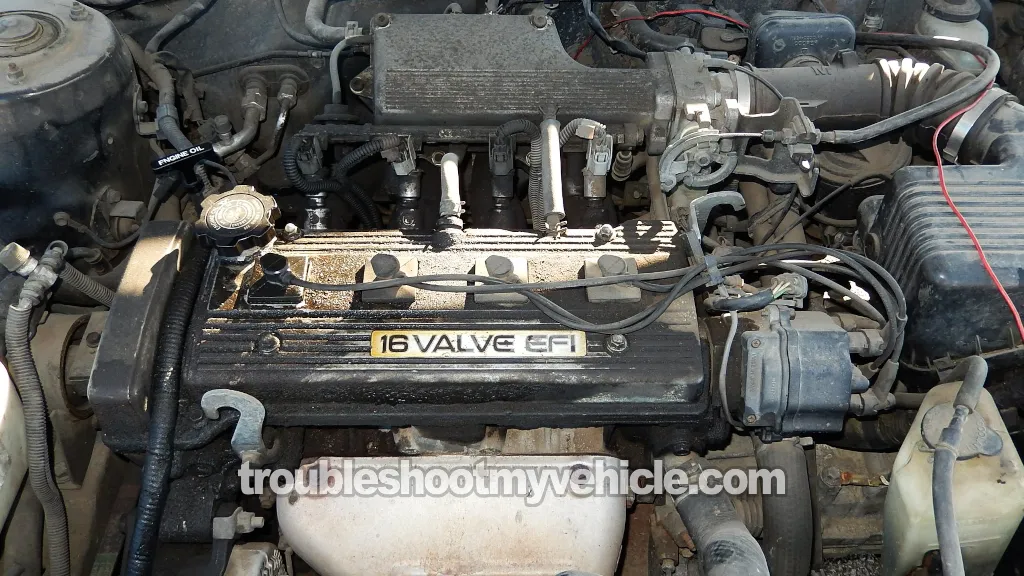
The 1.6L 4A-FE and 1.6L 4A-GE Toyota engines on the 1989-1997 Corolla are timing belt driven engines. If it breaks, your Corolla's engine is gonna crank but won't start.
I'm gonna walk you through the tests that'll help you figure out if a busted timing belt is why your engine won't start.
NOTE: Your Corolla's 1.6L 4A-FE and 1.6L 4A-GE engines are non-interference, so if the timing belt breaks, you won't have to worry about wrecked pistons or bent valves.
Contents of this tutorial:
- What Does The Timing Belt Do?
- Symptoms Of A Broken Timing Belt.
- TEST 1: Checking Distributor Rotor Rotation.
- TEST 2: Observing Camshaft Rotation.
- TEST 3: Inspecting The Timing Belt Via Upper Timing Cover (1989-1992).
- TEST 4: Check For Zero Engine Compression.
- TEST 5: Inspect For Timing Belt Service History.
- More 1.6L Toyota Corolla Tutorials.
APPLIES TO: This tutorial applies to the following vehicles:
- 1.6L (4A-FE) Toyota Corolla: 1989, 1990, 1991, 1992, 1993, 1994, 1995, 1996, 1997.
- 1.6L (4A-GE) Toyota Corolla: 1989, 1990, 1991.
- 1.6L Geo Prizm: 1993, 1994, 1995, 1996, 1997.
Engine No-Start Diagnostics:
- How To Troubleshoot An Engine No-Start Problem (1989-1992 1.6L Toyota Corolla).
- How To Troubleshoot An Engine No-Start Problem (1993-1997 1.6L Toyota Corolla).
What Does The Timing Belt Do?
The timing belt (t-belt) keeps the crankshaft and camshaft(s) turning together. If they fall out of sync, your engine's gonna run rough —or not at all.
- Crankshaft: Turns the pistons' up-and-down motion into rotation.
- Camshaft(s): Controls the intake and exhaust valves, letting in the air/fuel mix and letting out exhaust.
The t-belt makes sure the valves open and close at the right time so they match up with the pistons. This timing keeps the engine's four-stroke cycle (intake, compression, combustion, and exhaust) working right.
Symptoms Of A Broken Timing Belt
If the timing belt breaks on the 1989-1997 Toyota Corolla 1.6L (4A-FE or 4A-GE), here's what you'll notice:
- Engine cranks but won't start:
- Turn the key, and the engine's gonna crank, but it won't fire up.
- The belt keeps the crankshaft and camshafts in sync. If it breaks, the camshafts stop turning, which shuts down the intake and exhaust valves.
- Since the distributor is connected to one of the camshafts, that also means no spark.
- No moving valves and no spark = no air/fuel coming in, no compression, no combustion, and no exhaust going out.
- Engine cranks faster than usual:
- With no compression in any cylinder, the engine's gonna crank a lot quicker than normal (and it's gonna be very noticeable).
- Since the valves stay put without the timing belt, nothing compresses the air/fuel mix while cranking. This translates into a fast cranking speed.
- Zero compression in all cylinders:
- A compression test will show 0 PSI in all cylinders. Since the valves aren't opening or closing, there's nothing to compress.
- That almost always points to a broken timing belt or a serious timing issue.
- No camshaft/valve movement:
- If you remove the upper timing cover or the cylinder head valve cover and crank the engine, you'll see the camshafts aren't moving.
- No spark:
- Since both the 4A-FE and 4A-GE 1.6L engines use a distributor connected to one of the camshafts, the broken belt stops the distributor rotor from spinning, so the spark plugs aren't gonna fire spark.
NOTE: The 1.6L (4A-FE and 4A-GE) in your 1989-1997 Toyota Corolla is a non-interference engine, meaning a broken timing belt won't cause internal piston/valve damage.
TEST 1: Checking Distributor Rotor Rotation
As I've mentioned before, the Corolla's 1.6L (4A-FE/4A-GE) engine uses a distributor-based ignition system. If the timing belt breaks, the camshafts stop turning, which means the distributor rotor won't spin when you crank the engine.
- How to check:
- Unplug the distributor's electrical connectors.
- Take off the distributor cap.
- Have a helper crank the engine.
- Watch the rotor while the engine is cranking.
- If the rotor doesn't move, the timing belt's probably broken.
NOTE: In some very rare cases, I've seen the camshaft that drives the distributor break in half. This type of issue also stops the distributor rotor from spinning and causes an engine no-start.
TEST 2: Observing Camshaft Rotation
Your Corolla's 1.6L engine runs two camshafts, both powered by the timing belt. If the belt snaps, those camshafts aren't gonna turn when you crank the engine.
Pulling off the cylinder head valve cover lets you check if the camshafts are spinning or just sitting still (while you crank the engine).
On the 1993-1997 Corollas, removing the valve cover will also expose the timing belt/camshaft timing gear and you'll be able to physically see the condition of the timing belt!
- How to check:
- Take off the valve cover.
- 1993-1997 Corolla: Check the condition of the timing belt.
- 1989-1992 Corolla: Crank the engine and watch the camshafts.
- If they don't move, the timing belt's busted.
TEST 3: Inspecting The Timing Belt Via Upper Timing Cover (1989-1992)
The most accurate way you can check the timing belt's condition is by taking off the upper timing cover.
This is the most time-consuming method since it requires removing the cylinder head valve cover and a few other components to get full access to the belt.
But once the top timing cover is off, you'll get a clear view of its condition —fraying, cracks, or a complete break will be obvious.
NOTE: A repair manual might come in handy for step-by-step instructions on removing the cover.
- How to check:
- Take off the cylinder head valve cover.
- Take off the upper timing cover.
- Look for damage or fraying. If the belt's broken, it'll be obvious.
TEST 4: Check For Zero Engine Compression
When the timing belt breaks, valve timing goes out the window, and every cylinder loses compression. That makes the engine crank faster than normal —but it still won't start.
A compression tester is a must-have tool to check all four cylinders.
NOTE: This engine compression tutorial walks you through the compression test step by step and explains how to read the results: How To Test Engine Compression (1989-1997 1.6L Toyota Corolla).
- How to check:
- Take out all four spark plugs.
- Test the compression in each cylinder.
- If every cylinder reads 0 PSI, the timing belt's probably broken.
TEST 5: Inspect For Timing Belt Service History
The timing belt on 4A-FE and 4A-GE engines needs replacing every 60,000–90,000 miles. If it's overdue, and the engine cranks but doesn't start, there's a higher chance the t-belt is broken.
More 1.6L Toyota Corolla Tutorials
You can find a complete list of 1.6L Toyota Corolla tutorials and wiring diagrams in this index:
Here's a sample of the tutorials you'll find there:
- How To Test A Blown Head Gasket (1989-1997 1.6L Toyota Corolla).
- How To Do A Cylinder Balance Test (1989-1997 1.6L Toyota Corolla).
- How To Test Engine Compression (1989-1997 1.6L Toyota Corolla).
- How To Test The Throttle Position Sensor (1989-1997 1.6L Toyota Corolla).

If this info saved the day, buy me a beer!

